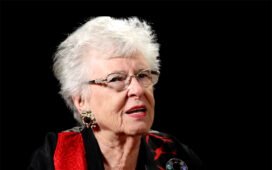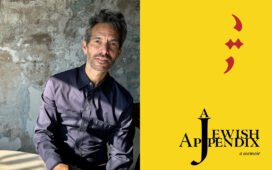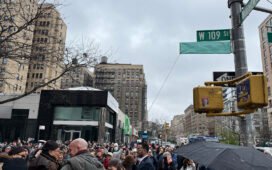(RNS) — The sounds of Jewish prayer rang out in Prague’s Klausen Synagogue on Saturday (Oct. 12) for the first time in more than 80 years as the city’s progressive Jewish community, Ec Chajim, hosted Yom Kippur services in its 330-year-old building.
Though not the oldest, Klausen is the city’s largest synagogue and the last standing example of baroque synagogue architecture in Prague, itself once a major center of European Jewish history. Its Jewish community yielded several notable figures, including novelist Franz Kafka and former U.S. Secretary of State Madeleine Albright.
In the 17th century, Klausen Synagogue was home to a school founded by Rabbi Judah Loew, more commonly known as “the Maharal,” a major rabbinic figure who today is mostly remembered for his association with the mythical golem of Prague, a superhuman he allegedly created to fight back against antisemitic persecution.
The synagogue has largely been a museum since the Nazis decimated Czechoslovakia’s Jewish community in the Holocaust. Before this year the last services in Klausen are believed to have been held in 1941. In October of that year, the Nazis began their deportations of Czech Jews to ghettos and concentration camps, where the overwhelming majority would perish.
“I feel both privileged and deeply humbled that our community has the honor of ensuring the voices of Jewish prayer will once again resonate within the sacred walls of the Klausen Synagogue,” said Rabbi David Maxa, 38, spiritual leader of Ec Chajim, in a statement. “This moment is not just a revival of our prayers, but a powerful testament to the resilience and continuity of our tradition.”

The Klausen Synagogue is Prague’s largest standing synagogue and is now largely used as a museum. Photo by Dana Cabanova, courtesy of the Jewish Museum in Prague
Before the Second World War, nearly 120,000 Jews lived in Czechoslovakia’s Bohemian and Moravian regions, which make up today’s Czechia. By the war’s end, barely 17,000 of them were left alive, and today only 3,500 call the country home, most of whom live in the capital, Prague.
The return to one of Prague’s most prominent synagogues also speaks to the resilience of Maxa’s own community, Ec Chajim. Maxa, 38, the son of a Holocaust survivor who fathered him late in life, is the only Reform rabbi in Czechia, where most Jewish institutions, as in much of Europe, are Orthodox.
But Reform Judaism is not something alien to Prague: Liberal Jewish movements first began to take shape in Central Europe in the late 1700s, amid the period known as the Haskalah, often called the Jewish Enlightenment.
“It’s true, in many cases, that in continental Europe progressive Judaism is today a minority. However, before the war it was a very significant stream, especially here in Prague and the rest of this central European area,” said Maxa.
In the wake of the Holocaust and repression of religion under 70 years of communist rule in Czechoslovakia, he pointed out, many Czechs cut their ties with the Jewish community. Maxa’s father was one of them. “For him and for many of his generation, Jewish identity was a kind of stigma, and also it had a certain trauma with it,” Maxa explained.

Pavla Niklová, director of the Jewish Museum in Prague, lights the Sabbath candles as Ec Chajim’s Rabbi David Maxa watches nearby during Yom Kippur services on Oct. 12, 2024, in the Klausen Synagogue in Prague. Photo by Dana Cabanova, courtesy of the Jewish Museum in Prague
However, the Velvet Revolution, which toppled the anti-religious Soviet-backed regime in 1989, also led to a resurgence of Jewish life that has continued in the former Czechoslovakia, which separated into the Czech Republic and Slovakia in 1992. (Though officially still the Czech Republic, the country adopted the name Czechia in 2016.)
Maxa said this history supports his belief that the 3,500 self-identified Jews in Czechia live among a potentially much larger pool of those with some Jewish ancestry. In 2019, Maxa and a cadre of collaborators founded Ec Chajim for those interested in connecting with that heritage.
“There are people with many Jewish biographies here in Prague,” Maxa explained. “There are people who grew up Jewishly. There are people who didn’t grow up so, but who then later found out that their roots were Jewish. There are also people who decided to become Jewish without any previous connections with Judaism. And there are also all sorts of other stories.”
Maxa himself began to explore his Jewish identity as a teenager in the 2000s and eventually decided to pursue rabbinical studies. After graduating from Abraham Geiger College, a Jewish seminary in Germany, and then Hebrew Union College in New York, he returned to Prague.
“Our community and also myself are involved in revitalizing Jewish life here,” Maxa told RNS. “We’ve been trying to look for opportunities to simply do things in a new way, in a modern way,” Maxa added. “There’s a real hunger for this in Prague.”
While other Jewish communities across Europe do similar work, Maxa said more conservative forms of Judaism fail to answer the need. “I would say that progressive Judaism now plays quite an important role in Prague and beyond, because it manages to address many people who wouldn’t otherwise relate to the Jewish community and who find its values attractive,” Maxa said.

Ec Chajim’s congregation stands together during Yom Kippur services on Oct. 12, 2024, at the Klausen Synagogue in Prague. Photo by Dana Cabanova, courtesy of the Jewish Museum in Prague
That’s particularly important in Czechia, which is the most irreligious country in Europe, with nearly half of its population not identifying as affiliated with any faith.
The Yom Kippur service gave Maxa hope that Judaism has a diverse future in Prague. “I would say the strongest moment was when we were singing one of the prayers I prepared with the children from our community. The children, without being asked, came to the bimah and all of them — it must have been about 30 or 40 children — started to sing that prayer together with us,” Maxa said.














